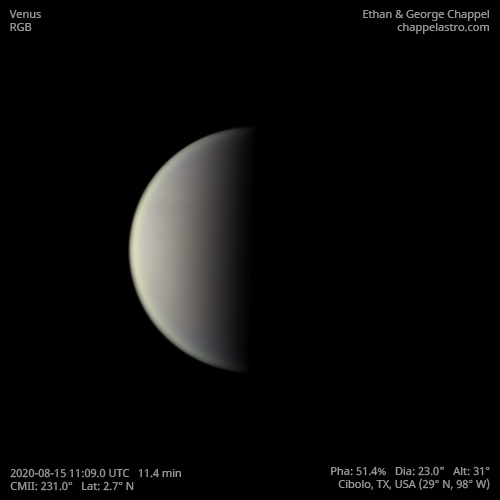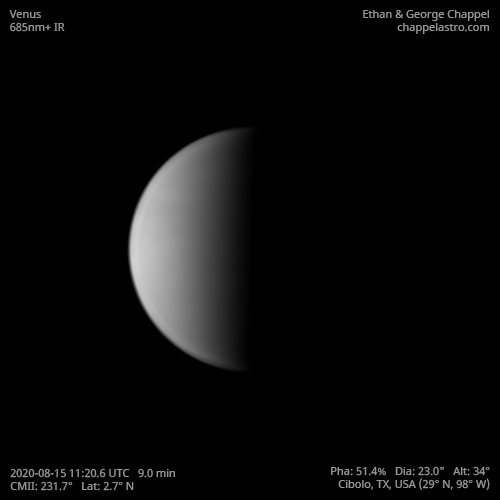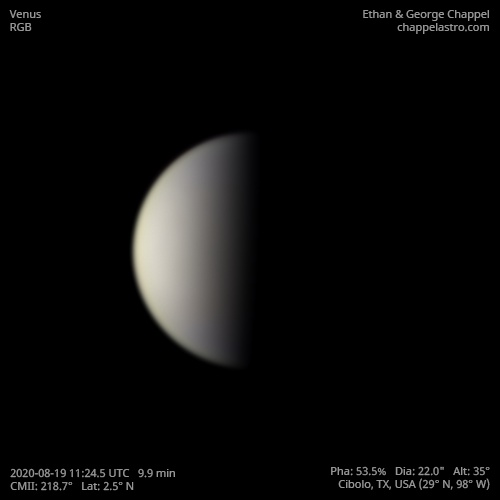Venus 2020
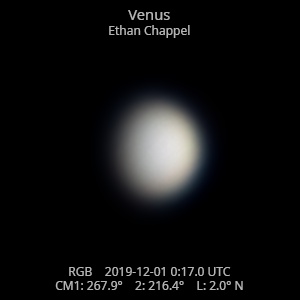
UTC
My first image of Venus since January. I'm hoping to spend more time on the brightest planet in the sky starting this apparition.
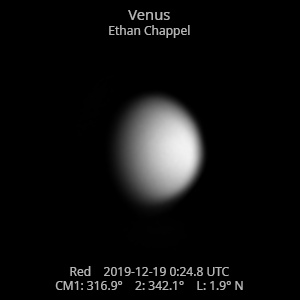
UTC
A difficult night of imaging. Seeing was bad enough to make the green and blue recordings useless, something I haven't experienced in a while.
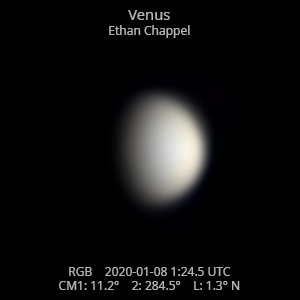
UTC
Improved conditions for imaging compared to December as Venus' elongation from the Sun increases. Tonight it is 80% illuminated and decreasing as it catches up with Earth.
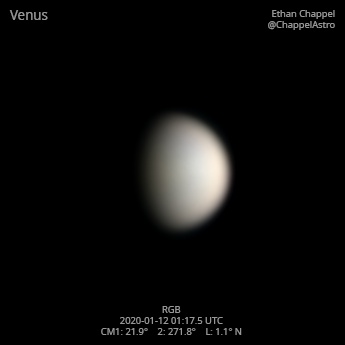
UTC
Tonight was a chilly one, but it was worth the improved conditions for imaging. This was a first light for my ZWO EFWmini and Celestron StarPointer Pro. The EFWmini is surprisingly quiet compared to other electronic filter wheels I have used. The StarPointer Pro also works great, but I recommend finding a mounting bracket for red dot finders if you have an SCT and need to remove it after every session.
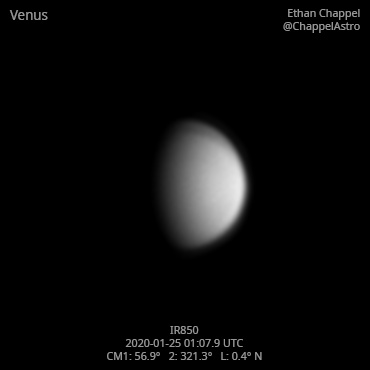
UTC
Pretty good night of imaging. Seeing was good, while transparency was excellent as usual for this time of year. Tonight was the first light of my new ZWO IR850 filter. I was hoping to see some details in the clouds with this filter, but it seems like that goal will have to wait.
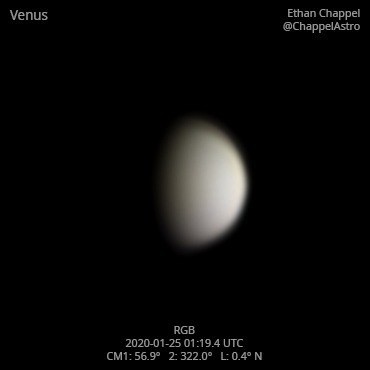
UTC
Pretty good night of imaging. Seeing was good, while transparency was excellent as usual for this time of year. Tonight was the first light of my new ZWO IR850 filter. I was hoping to see some details in the clouds with this filter, but it seems like that goal will have to wait.
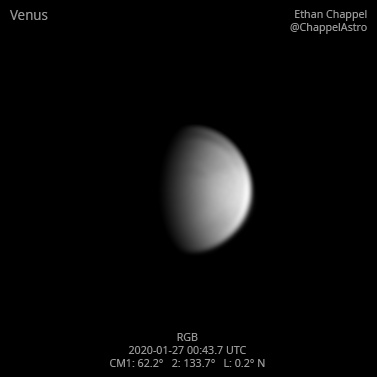
UTC
Much improved session compared to the previous one two nights earlier. The temperature was surprisingly comfortable for this part of winter.
For the first time, I can see cloud details in one of my Venus images!
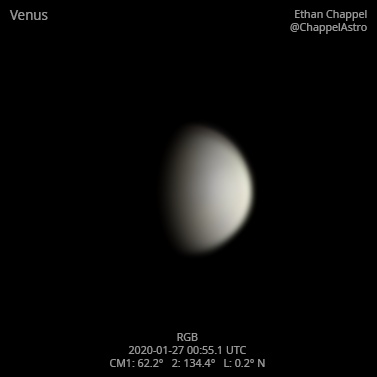
UTC
Much improved session compared to the previous one two nights earlier. The temperature was surprisingly comfortable for this part of winter.
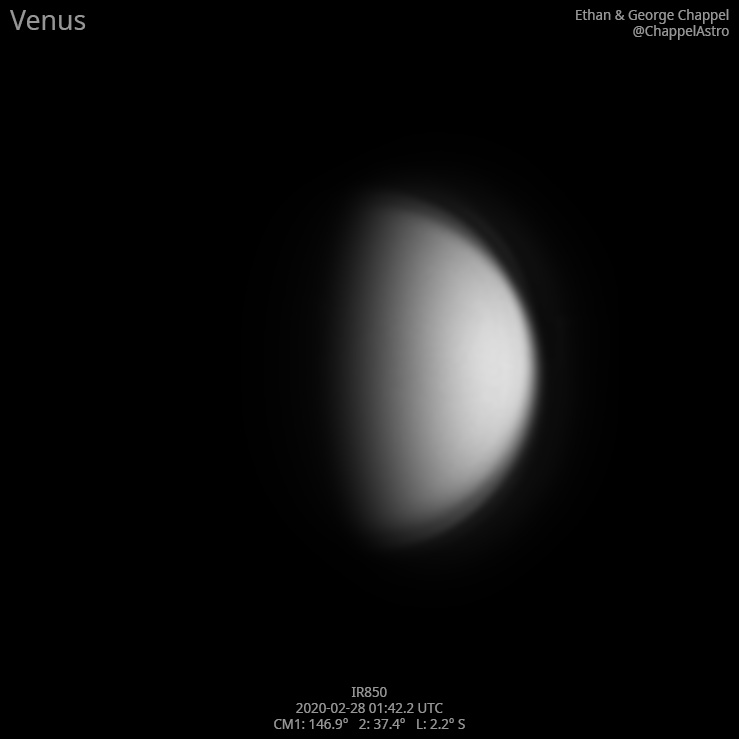
UTC
A decent night for imaging. Racing against the clock to catch Venus before it sunk too low in the sky made for a difficult session. This was the first time using the C14 to image Venus.
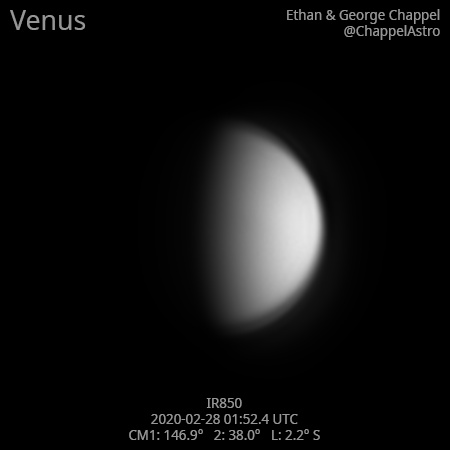
UTC
A decent night for imaging. Racing against the clock to catch Venus before it sunk too low in the sky made for a difficult session. This was the first time using the C14 to image Venus.

UTC
A decent night for imaging. Racing against the clock to catch Venus before it sunk too low in the sky made for a difficult session. This was the first time using the C14 to image Venus.
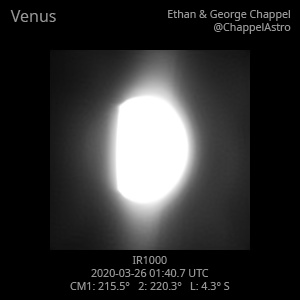
UTC
Much better night for imaging Venus with the C14 than the last session a month ago.
First light of my Thorlabs FELH1000. A filter like this blocks most light reflected off the thick sulfuric acid clouds on the day-side. The clouds also happen to be translucent at 1000nm, allowing the faint infrared light emitted by the surface to be seen on the night-side.
I couldn't have done this without some research and asking around. Here are resources I found useful:
Image the surface of Venus this winter!
ThorLabs 1 micron filter for Venus - Solar System Imaging & Processing - Cloudy Nights
Stuck with researching Venus imaging at 1 micron - Solar System Imaging & Processing - Cloudy Nights

UTC
Much better night for imaging Venus with the C14 than the last session a month ago.
After finishing up with the Thorlabs FELH1000, I swapped to the usual imaging train for an RGB image.
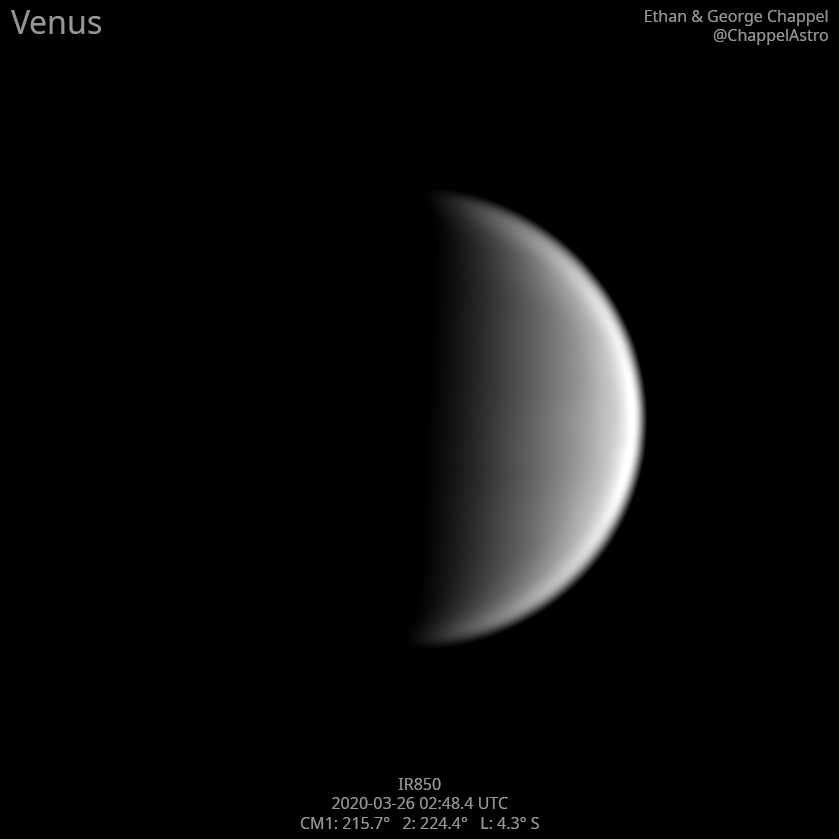
UTC
Much better night for imaging Venus with the C14 than the last session a month ago.
I applied a stronger sharpening than usual to bring out the faint details in the clouds.
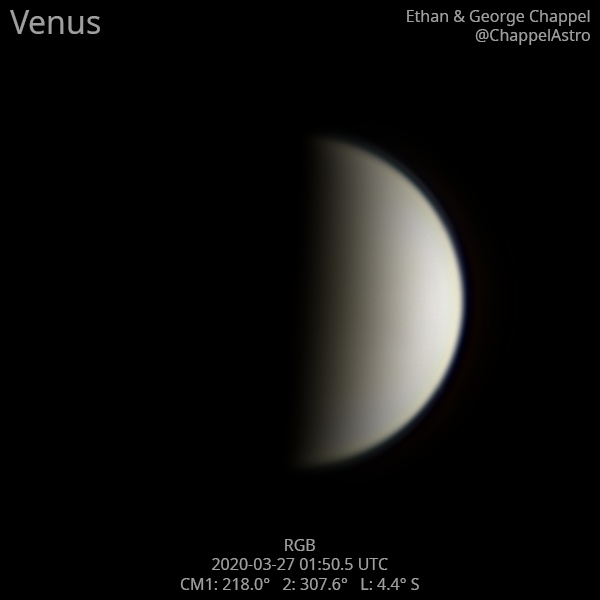
UTC
Second consecutive night of stable imaging conditions for Venus. We are now a few days beyond greatest elongation from the Sun.
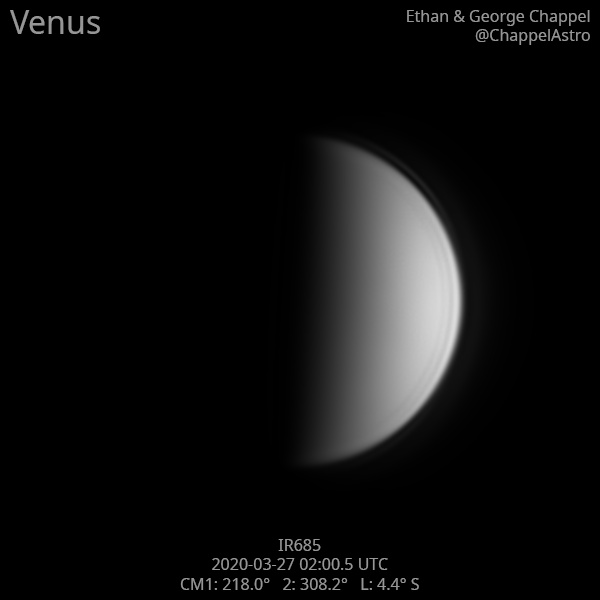
UTC
Second consecutive night of stable imaging conditions for Venus. We are now a few days beyond greatest elongation from the Sun.

UTC
Second consecutive night of stable imaging conditions for Venus. We are now a few days beyond greatest elongation from the Sun.
After a successful attempt with relatively little data on the 26th, I assumed using more data would guarantee a better image of the night side, but I think that turned out wrong. My two ideas for why are either a slightly shorter exposure (300ms on the 26th, 280ms here) or the conditions were less favorable for catching 1000nm light.
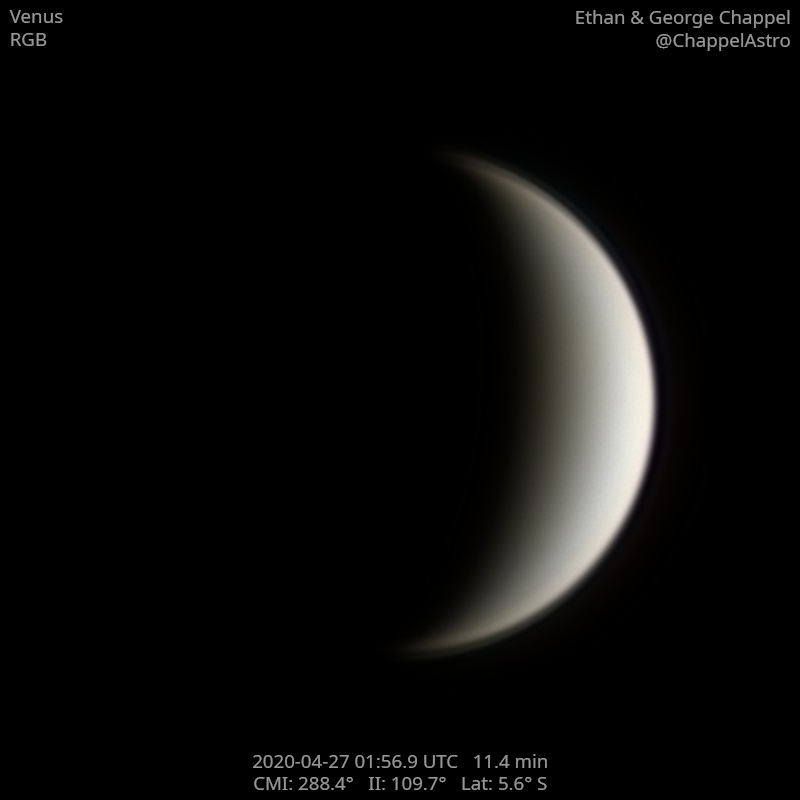
UTC
Turbulent seeing for this imaging session of Venus, but the high surface brightness of the sulfuric acid clouds allows me to capture large amounts of data very quickly.

UTC
The thinner crescent of the day side and larger angular diameter made it much easier to catch thermal emissions from the night side.
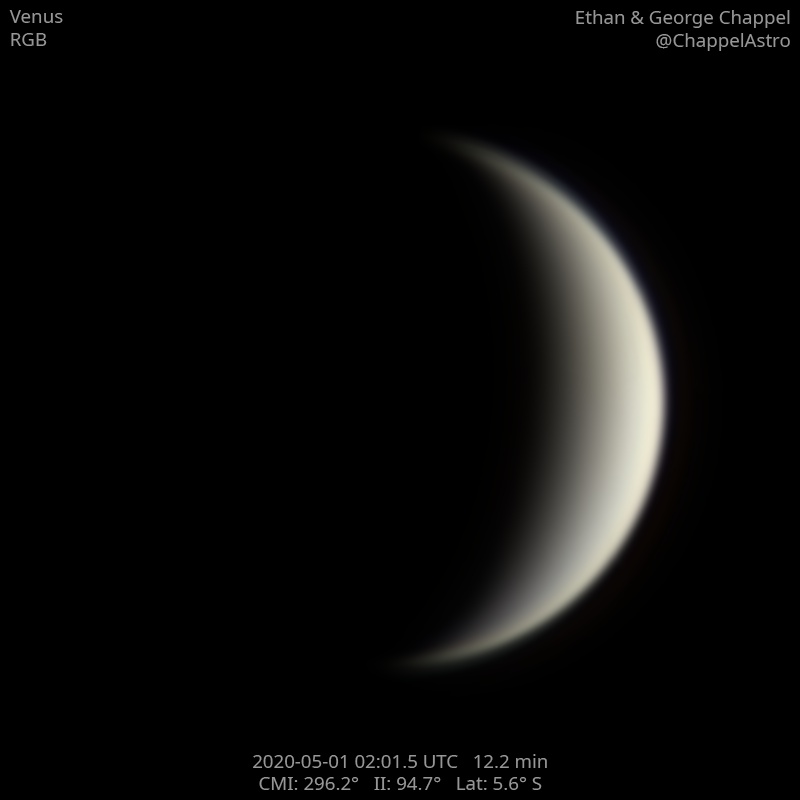
UTC
Very turbulent seeing on this evening. Venus is starting to drop lower at a faster pace. It will be become hard to image in a few weeks.
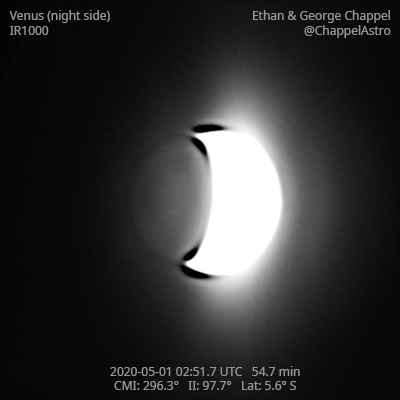
UTC
Very turbulent seeing on this evening. Venus is starting to drop lower at a faster pace. It will be become hard to image in a few weeks.
I rotated the camera occasionally to reduce optical artifacts. Seems to be a strategy that works well.
Notes:
- Beta Regio is visible as a dark spot near the crescent.
- Atla Regio may be visible on the western limb.
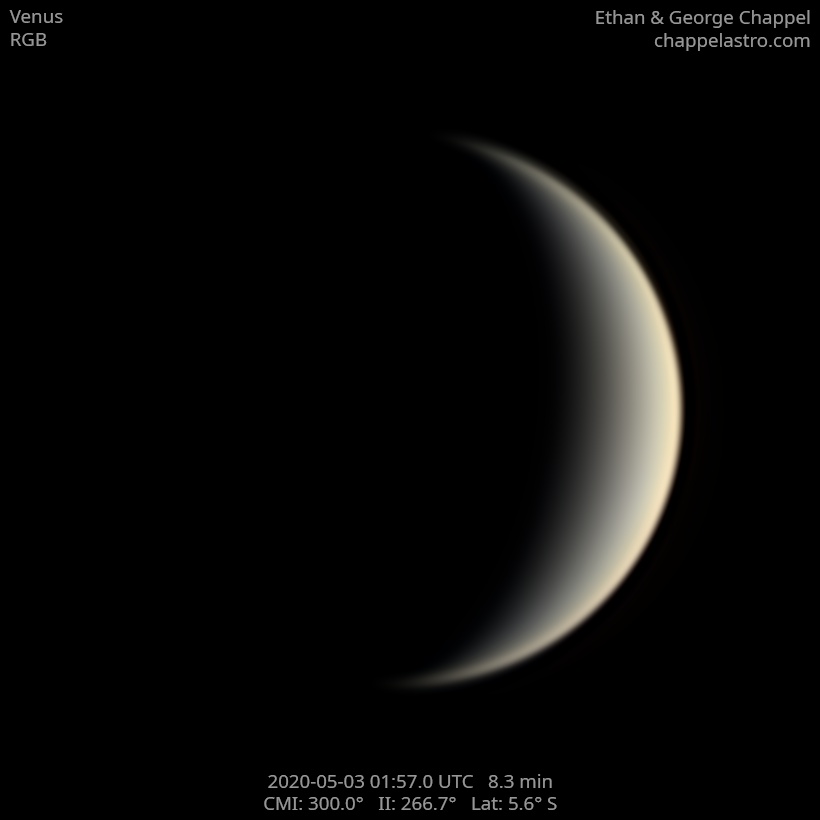
UTC
Much better seeing than a couple days ago. Clouds rolled in before I had a chance to capture images of the night side at 1000nm.
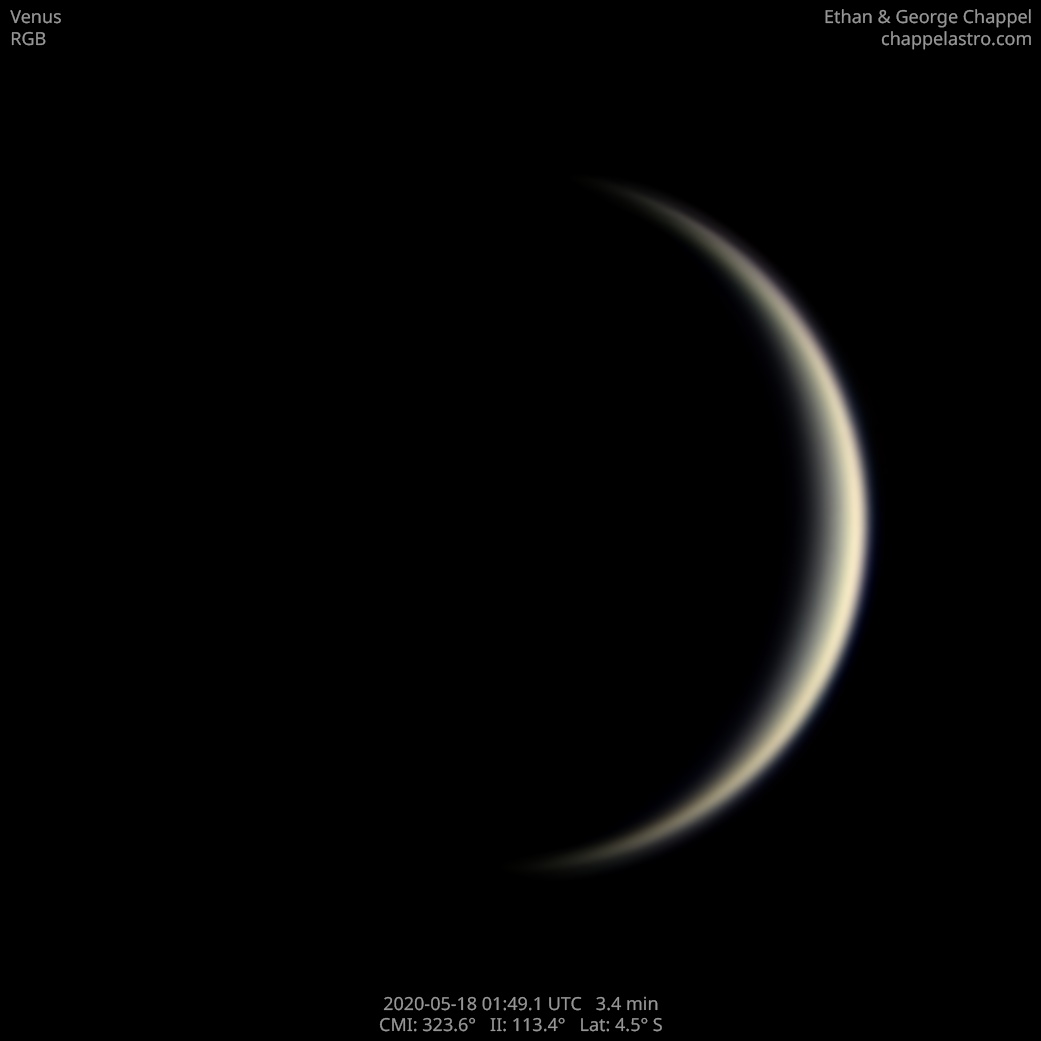
UTC
Tough seeing conditions as Venus rapidly closes in on inferior conjunction with the Sun. Venus has exceeded 50 arc-seconds of angular diameter.
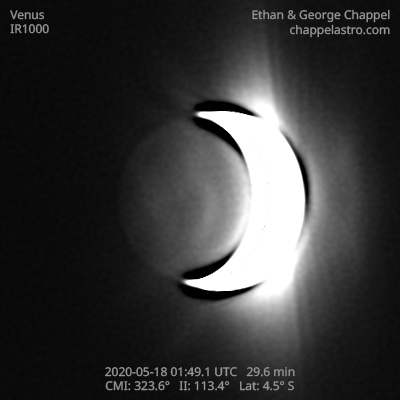
UTC
Tough seeing conditions as Venus rapidly closes in on inferior conjunction with the Sun. Venus has exceeded 50 arc-seconds of angular diameter.
There are many ghost images of the day-side crescent, but it appears that Beta Regio is visible as a dark spot near the limb on the northern hemisphere.

UTC
Got a late start on imaging this evening. Skipped capturing an RGB image to have enough time to collect enough 1000nm data.
Notes:
- Beta Regio is visible as a dark spot near the limb on the northern hemisphere.

UTC
Another day of only imaging Venus with the 1000nm filter.
Notes:
- Beta, Phoebe, and Themis Regio are visible as dark spots near the limb of the night side.
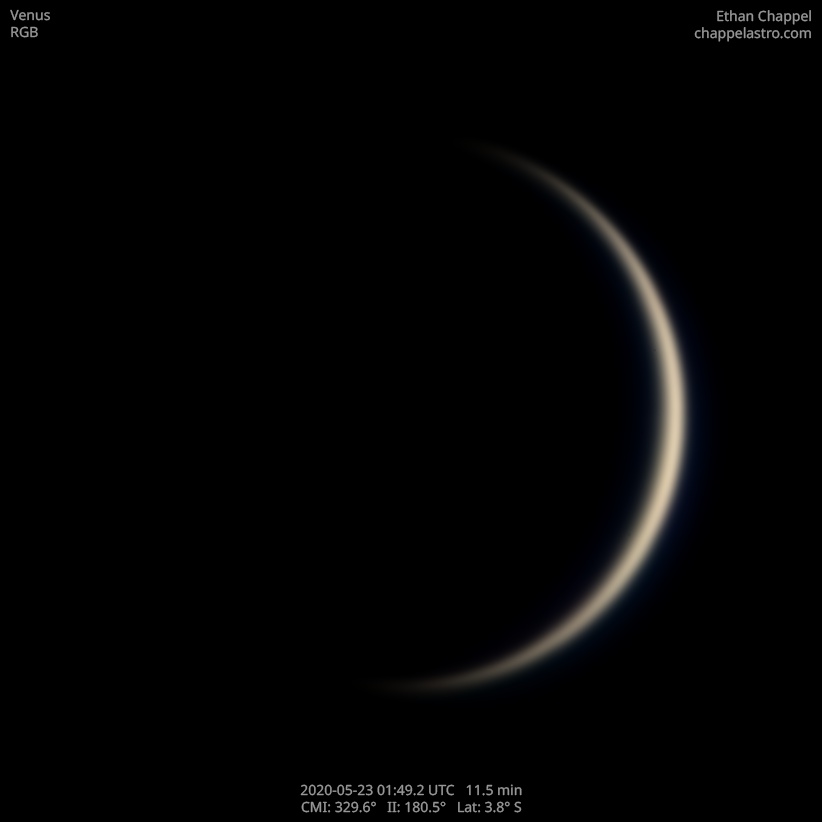
UTC
I didn't expect to have another opportunity to image Venus before inferior conjunction, but the sky cleared long enough for me to put out the C8 and image the planet as a thin crescent.
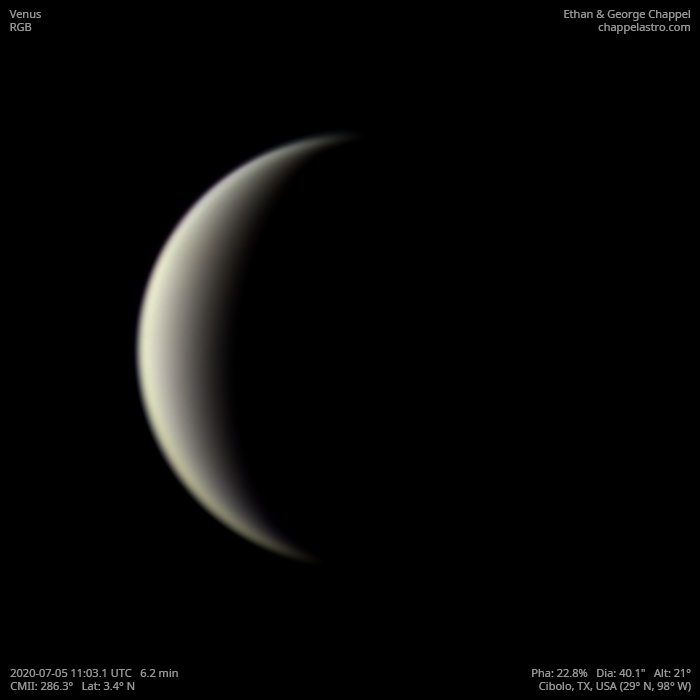

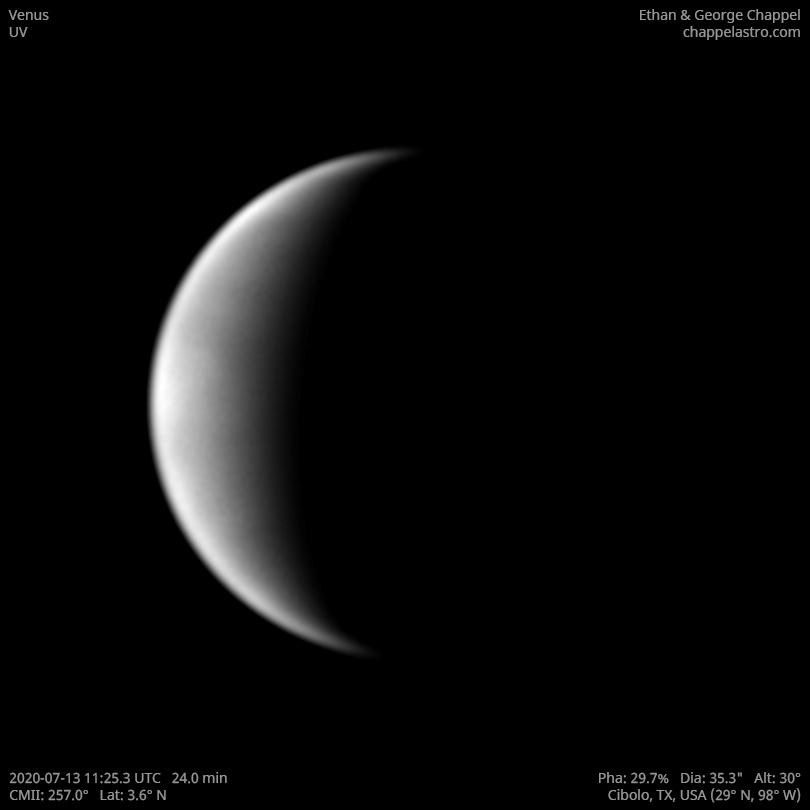
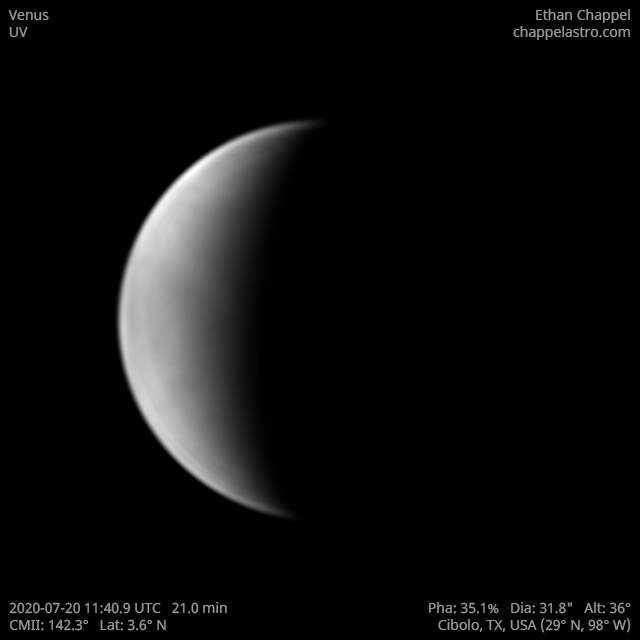
UTC
Great seeing conditions. Cloud features that are very subtle in visible light are easier to see in ultraviolet.
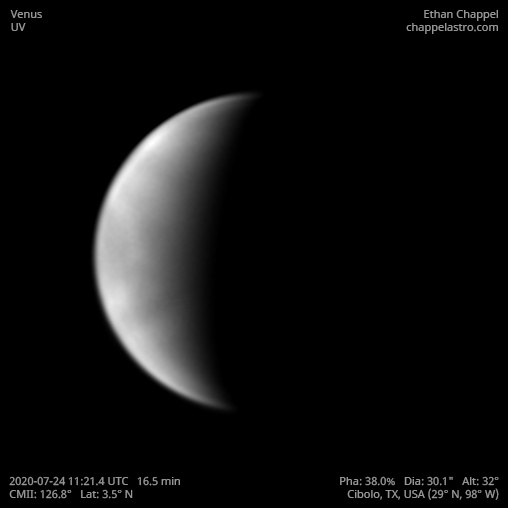

UTC
One of the best imaging runs I have had with Venus this year. This was the first time I created a bi-color IR-UV image, a common palette used when imaging this planet.

UTC
One of the best imaging runs I have had with Venus this year. This was the first time I created a bi-color IR-UV image, a common palette used when imaging this planet.

UTC
One of the best imaging runs I have had with Venus this year. This was the first time I created a bi-color IR-UV image, a common palette used when imaging this planet.
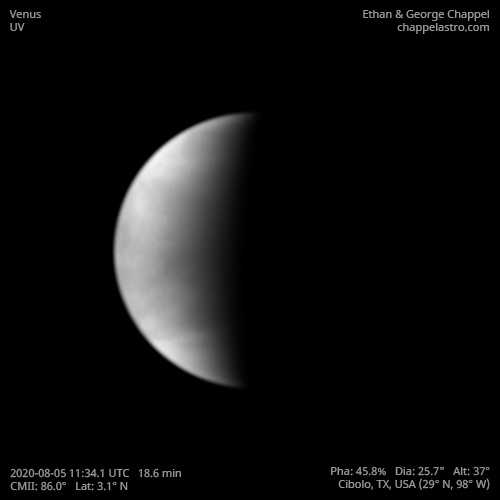
UTC
One of the best imaging runs I have had with Venus this year. This was the first time I created a bi-color IR-UV image, a common palette used when imaging this planet.
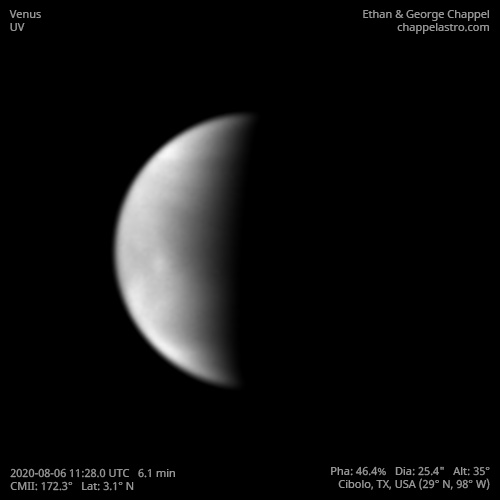
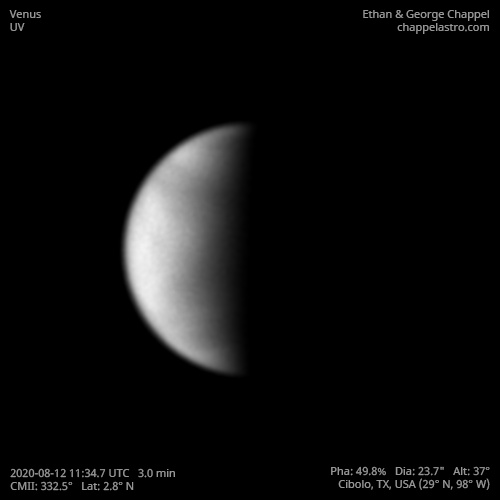
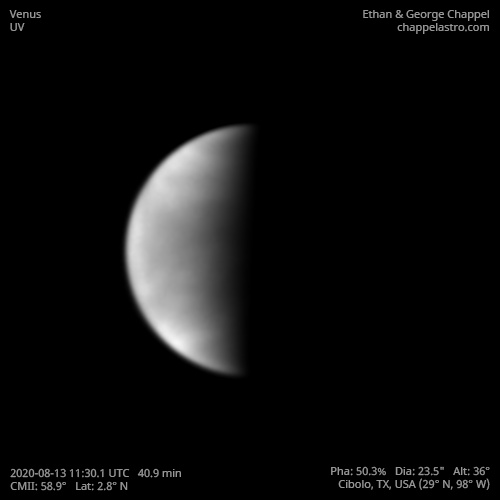
UTC
Very good seeing and the first night with no clouds coming in from the south, a typical occurrence at some point every summer night. Many details are visible in the swirling cloud-tops.
